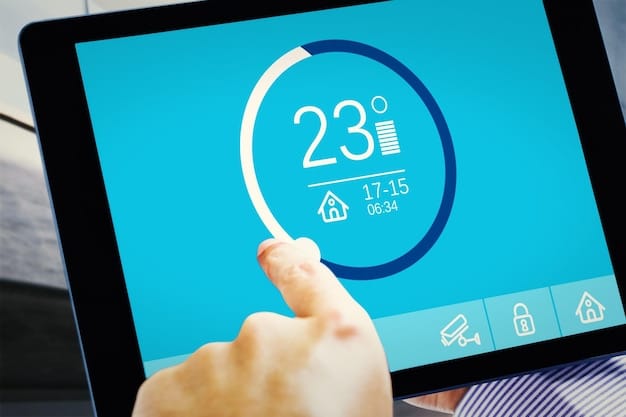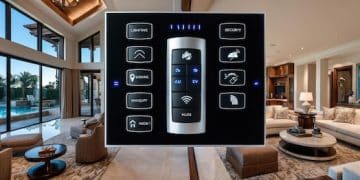Smart Home Privacy in 2025: Your Data, Your Control

Smart home privacy in 2025 involves understanding evolving data collection practices, adopting proactive security measures, and making informed choices to protect personal information within increasingly interconnected home environments.
The **smart home and privacy: understanding and protecting your data in 2025** will be paramount. As our homes become increasingly filled with interconnected devices, the amount of personal data generated and potentially shared is exploding. Let’s explore how to navigate this complex landscape and safeguard your privacy.
Understanding the Evolving Smart Home Landscape
The smart home ecosystem is constantly expanding, incorporating everything from smart thermostats to connected appliances. This interconnectedness, while offering convenience, also introduces new vulnerabilities to your personal data.
The Proliferation of Smart Devices
The sheer number of smart devices in the average home is expected to increase dramatically by 2025. Each device serves as a potential entry point for data collection and security breaches.
Data Collection Practices
Understanding what data your smart devices collect is crucial. Many devices gather information about your habits, preferences, and even your physical location within your home.
- Review the privacy policies of each smart device manufacturer.
- Understand what data is being collected and how it’s being used.
- Opt-out of data collection where possible.
- Regularly update your device software to patch security vulnerabilities.
Ultimately, being aware of the expanding smart home environment and the implications of data collection is the first step toward protecting your privacy.

Assessing Your Smart Home Privacy Risks
Identifying potential privacy risks is vital for creating a secure smart home. This involves evaluating your devices, your network, and your data security practices.
Identifying Vulnerable Devices
Some smart devices are inherently more vulnerable than others. Older devices or those with weak security protocols can be easily exploited by hackers.
Weak Wi-Fi Security
A poorly secured Wi-Fi network is a major point of vulnerability. Cybercriminals can access your network and potentially control your smart devices.
- Use a strong, unique password for your Wi-Fi network.
- Enable WPA3 encryption for enhanced security.
- Regularly check your router’s security settings.
- Consider using a separate guest network for less critical devices.
By taking a proactive approach to risk assessment, you can significantly strengthen your smart home’s privacy defenses.
Implementing Strong Security Measures
Once privacy risks are identified, implementing strong security measures is crucial. These measures include securing your Wi-Fi network, using strong passwords, and enabling two-factor authentication.
Securing Your Wi-Fi Network
Your Wi-Fi network is the gateway to your smart home. Strengthening its security is paramount.
Utilizing Strong Passwords
Weak or default passwords are an easy target for hackers. Use strong, unique passwords for all your smart devices and accounts.
- Use a password manager to generate and store strong passwords.
- Avoid using the same password for multiple accounts.
- Change your passwords regularly.
- Enable biometric authentication where possible.
By consistently applying these security measures, you reduce the risk of unauthorized access to your personal data.

Data Encryption and VPNs for Smart Homes
Data encryption and Virtual Private Networks (VPNs) provide an additional layer of security for your smart home, protecting your data from interception and unauthorized access.
Understanding Data Encryption
Data encryption scrambles information, making it unreadable to unauthorized parties. This safeguards your data as it travels between devices and servers.
The Role of VPNs
A VPN creates a secure, encrypted connection between your devices and the internet, masking your IP address and protecting your online activity from prying eyes.
- Choose a reputable VPN provider with a strong privacy policy.
- Configure your router to use the VPN for all your smart home traffic.
- Use encryption protocols like AES-256 for maximum security.
- Regularly update your VPN software to patch security vulnerabilities.
Together, data encryption and VPNs significantly enhance the privacy and security of your smart home.
Managing Device Permissions and Data Sharing
Smart devices often request extensive permissions to access your data. Managing these permissions and controlling data sharing settings are vital aspects of protecting your privacy.
Reviewing App Permissions
Regularly review the permissions granted to apps connected to your smart devices. Revoke any permissions that seem excessive or unnecessary.
Controlling Data Sharing Settings
Most smart device manufacturers allow you to control how your data is shared. Review and adjust these settings to limit the information shared with third parties.
- Opt-out of data sharing for advertising purposes.
- Limit the amount of personal information collected by your devices.
- Be cautious about linking your social media accounts to your smart home devices.
- Regularly review and update your privacy preferences.
By actively managing device permissions and data sharing settings, you maintain greater control over your personal information.
Privacy-Focused Smart Home Products and Practices
As awareness of privacy concerns grows, manufacturers are developing more privacy-focused smart home products. Adopting these products and practices can further enhance your data protection.
Choosing Privacy-Conscious Devices
Opt for smart devices that prioritize privacy and data security. Look for devices with end-to-end encryption, local data storage options, and transparent data policies.
Implementing Privacy-Enhancing Practices
In addition to using privacy-focused products, implement practices that minimize your data footprint. These include using strong passwords, enabling two-factor authentication, and regularly updating your device firmware.
- Research the privacy policies and security practices of different manufacturers.
- Choose devices that offer local data storage options.
- Use virtual assistants with strong privacy controls.
- Regularly review and update your smart home security settings.
By being selective in your product choices and proactive in your practices, you can create a smart home that respects your privacy.
| Key Point | Brief Description |
|---|---|
| 🔒 Secure Wi-Fi | Use strong passwords and WPA3 encryption to protect your network. |
| 🛡️ Encryption & VPN | Encrypt data and use a VPN to secure your online activity. |
| ⚙️ Manage Permissions | Regularly review and adjust app and device permissions. |
| ✅ Privacy Devices | Choose smart devices focused on privacy and local data storage. |
Frequently Asked Questions
▼
Check for devices with strong encryption, up-to-date security patches, and transparent privacy policies. Regular security audits and firmware updates are also good indicators.
▼
Two-factor authentication adds an extra layer of security by requiring a second verification method, like a code sent to your phone, making it harder for unauthorized users to access your devices.
▼
It’s recommended to update your passwords every three to six months. Regularly changing passwords helps prevent unauthorized access if a password becomes compromised.
▼
Default passwords are easily guessable or found online, making your devices vulnerable to hacking. Always change default passwords immediately after setting up a device.
▼
Review and adjust privacy settings, delete voice recordings regularly, and be mindful of what you say near the devices. Consider muting the microphone when not in use.
Conclusion
Protecting your privacy in the smart home era requires ongoing vigilance and proactive measures. By understanding the risks, implementing strong security practices, and choosing privacy-focused devices, you can enjoy the convenience of smart home technology while safeguarding your personal information.





